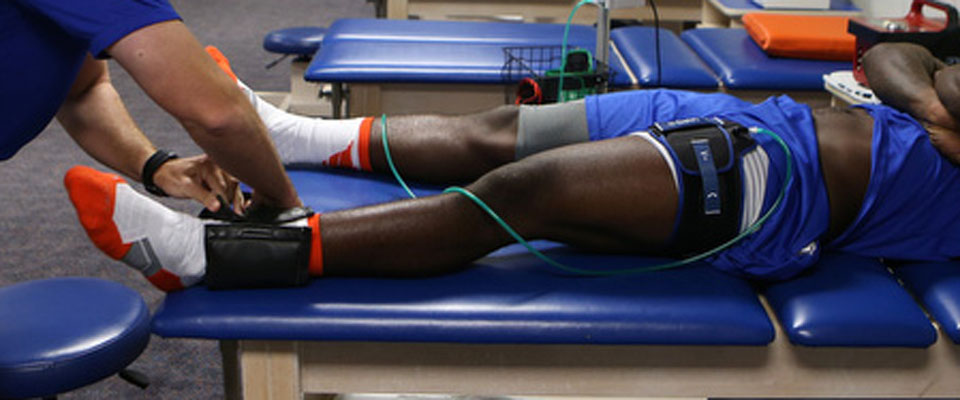
Article reposted from The Richmond Register
Author: The Richmond Register
Blood Flow Restriction, a new ground-breaking rehabilitation tool, is now being used in Eastern Kentucky University’s athletic training room thanks to a partnership between the department of sports medicine and the university’s athletic training education program.
Blood Flow Restriction (BFR) is currently being used by athletic trainers and sports medicine professionals in the National Football League (NFL), National Basketball Association (NBA) and Major League Baseball (MLB). The technique has also been featured on ESPN.
The two EKU departments recently hosted a BFR training and certification course that included athletic trainers and physical therapists from the University of Alabama, University of Kentucky, University of Georgia, University of Louisville, Memphis University and other regional outpatient clinics along with athletic trainers and athletic training education professors from Eastern Kentucky.
Eastern’s Dr. Eric J. Fuchs, ATC, EMT-B, director of the athletic training program, was first exposed to BFR while visiting EKU athletic training students completing clinical rotations at the University of Florida. After learning about this new rehabilitation technique, Fuchs became certified in BFR by attending a course through Owens Recovery Science in October 2015. He then met with EKU Director of Sports Medicine Jake Ryan, MS, ATC, to talk about the need to make this available to both EKU student-athletes and students in the athletic training program.
Fuchs worked to get funding to purchase a BFR Therapy unit for use in the education program and clinically with student-athletes. This collaboration between an academic program and athletics created an environment to help assure student-athletes are receiving the best evidence-based approaches for treatment, evaluation, diagnosis and rehabilitation, and students in the athletic training program are learning about the most advanced forms of rehabilitation, already being used by athletic trainers and sports medicine professionals at the highest level of sport.
The sports medicine department first began using BFR rehabilitation techniques in January. Since then, the results and response have been outstanding, creating the need for training of additional staff members. This has allowed for more student-athletes to have access to BFR during rehabilitation. Rather than attending training elsewhere, Fuchs and Ryan decided Eastern Kentucky University should be the leader in bringing BFR to the region. The duo brought a certification course to EKU and invited healthcare professionals throughout the region to attend.
BFR is the application of a specialized tourniquet system to a proximal arm or leg, which is inflated, to a personalized and specific pressure to reduce blood flow to an exercising extremity. The application is brief and intermittent, typically about 6 minutes per exercise but can last up to 30 minutes based on the specific protocol. Typically, to increase strength and hypertrophy a person would need to lift a significant amount of weight (60 percent of a one repetition maximum or greater). With BFR you can create significant strength and hypertrophy gains with loads as low as 20 percent 1RM.
BFR is an evidence-based practice method with proven evidence which has a substantial amount of literature that has studied the BFR effects. In fact, a recent meta-analysis found a total of 820 articles pertaining to BFR. The authors of the review concluded “Importantly, research suggests that low load resistance exercise (20–30 percent 1 RM) and low load aerobic exercise (<70 m/min walk training), which would not be expected to cause considerable increases in muscular quantity or quality under normal circumstances, when combined with BFR produced an exaggerated response for maximizing muscle strength and hypertrophy.”
BFR consistently demonstrates greater results compared to work matched controls exercising without BFR. The positive results have been seen in patients after injury, in the elderly, and in athletes. It has also been applied extensively in a military rehabilitation setting on severely compromised patients.
The increase in muscle strength and hypertrophy with light loads is very interesting. What are the main contraindications for this equipment and has there been any reports of blood vessel damage from using it?